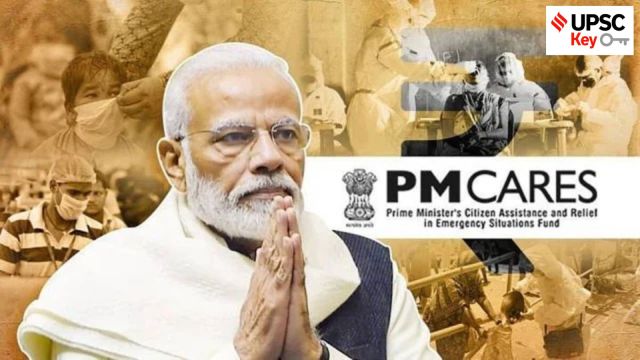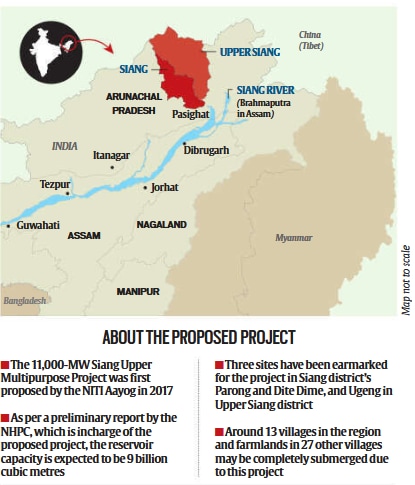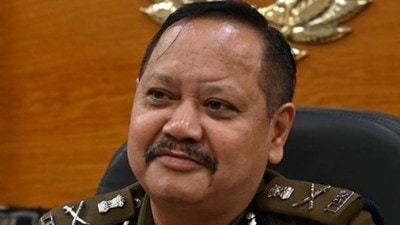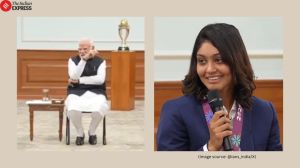
Mains Examination: General Studies-II: Government policies and interventions for development in various sectors and issues arising out of their design and implementation
What’s the ongoing story: The Prime Minister’s Citizen Assistance and Relief in Emergency Situations Fund (PM CARES Fund) received Rs 912 crore in contributions during the financial year 2022-23 as donations continued to pour in even after the Covid pandemic.
Key Points to Ponder:
Story continues below this ad
— What was the objective of introducing the PM CARES Fund?
— What are the criticisms related to the PM CARES Fund?
— Who can donate to the PM CARES Fund?
— What are the different funds of the government?
— How does Public Charitable Trust play an important role in developing an inclusive society?
— How is it different from the Prime Minister National Relief Fund (PMNRF)?
Key Takeaways:
Story continues below this ad
— The PM CARES Funds received Rs 909.64 crore as voluntary contributions and Rs 2.57 crore as foreign contributions during 2022-23, the latest year for which audited accounts are available in the public domain.
— In addition to donations of Rs 912 crore, the Fund also received Rs 170.38 crore as interest income, of which Rs 154 crore came from interest on regular accounts and Rs 16.07 crore from foreign contributions account.
— It also received about Rs 225 crore in form of refunds from various sources, including refund (Rs 202 crore) from procurement of 50,000 ‘Made in India’ ventilators to government hospitals run by the Centre/States/UTs.
— In all, the PM CARES Fund received a total of Rs 13,605 crore — as voluntary contributions (Rs 13,067 crore) and foreign contributions (Rs 538 crore) — in the four years from 2019-20 to 2022-23. During this period, it received Rs 565 crore as interest income.
Story continues below this ad
— The PM CARES Fund was registered as a Public Charitable Trust under the Registration Act, 1908 in New Delhi on March 27, 2020, three days after the lockdown in the country in the wake of the Covid-19 pandemic.
— It was set up “keeping in mind the need for having a dedicated fund with the primary objective of dealing with any kind of emergency or distress situation, like posed by the COVID-19 pandemic, and to provide relief to the affected.”
— The Prime Minister is the ex-officio chairman of the PM CARES Fund, while the Defence Minister, Home Minister and Finance Minister are ex-officio trustees of the Fund. The Prime Minister, as the chairperson of the Board of Trustees of the PM CARES Fund, has nominated Justice K T Thomas (retd.) and Kariya Munda as trustees.
Do You Know:
— In pursuance of an appeal by the then Prime Minister, Pt. Jawaharlal Nehru in January, 1948, the Prime Minister’s National Relief Fund (PMNRF) was established with public contributions to assist displaced persons from Pakistan.
Story continues below this ad
— The resources of the PMNRF are now utilized primarily to render immediate relief to families of those killed in natural calamities like floods, cyclones and earthquakes, etc. and to the victims of the major accidents and riots.
— Disbursements are made with the approval of the Prime Minister. PMNRF has not been constituted by the Parliament. The fund is recognized as a Trust under the Income Tax Act and the same is managed by Prime Minister or multiple delegates for national causes.
Other Important Articles Covering the same topic:
📍pmnrf.gov.in
Previous year UPSC Mains Question Covering similar theme:
Public health system has limitation in providing universal health coverage. Do you think that private sector can help in bridging the gap? What other viable alternatives do you suggest? (UPSC CSE 2015)
Syllabus:
Story continues below this ad
Preliminary Examination: Economic and Social Development – Sustainable Development, Poverty, Inclusion, Demographics, Social Sector Initiatives, etc
Mains Examination: General Studies-III: Indian Economy and issues relating to planning, mobilisation, of resources, growth, development and employment.
What’s the ongoing story: Reversing a declining trend from over a decade, the share of food in monthly expenditure of households in rural as well as urban areas went up in 2023-24, according to the Household Consumption Expenditure Survey (HCES) 2023-24 fact sheet released by the Ministry of Statistics and Programme Implementation (MoSPI) on Friday.
Key Points to Ponder:
— What is inflation and how is it calculated in India?
— What is the Household consumption expenditure?
— What is the Consumer Price Index?
— How is the inflation managed in India?
Story continues below this ad
— What are the reasons for the increase in food inflation?
— What is the purpose of the Gini coefficient?
— Why does the rise in food inflation impact rural and urban pollution differently?
Key Takeaways:
— This probably reflects the impact of higher food prices; given that the figures are in nominal terms, the share of food in the consumption basket of rural households went up to 47.04 per cent in 2023-24 from 46.38 per cent in 2022-23, while that for urban households inched higher to 39.68 per cent in 2023-24 from 39.17 per cent in the previous year.
— The HCES data also showed that the difference in average monthly consumption expenditure between rural and urban households narrowed further, which implies that rural consumption spending continued to rise more than urban consumption spending over the last one year.
Story continues below this ad
— Rural average monthly consumption spending per person increased to Rs 4,122 in 2023-24, an increase of 9.3 per cent from Rs 3,773 in 2022-23.
— A closer look at the fractile data reveals that the top 5 per cent of the rural and urban population saw a decrease in consumption spending in 2023-24, even as all other segments of the population, including the bottom 5 per cent, registered an increase in spending.
— The Survey report, however, pointed out that consumption inequality, both in rural and urban areas, has declined compared with 2022-23. The Gini coefficient declined to 0.237 in 2023-24 from 0.266 in 2022-23 for rural areas and to 0.284 in 2023-24 from 0.314 in 2022-23 for urban areas.
Do You Know:
— Food inflation — typically considered idiosyncratic — has stayed stubbornly elevated, restricting the fall in the consumer price index (CPI) and restraining the Monetary Policy Committee of the Reserve Bank of India.
Story continues below this ad
— Food commands nearly 40 per cent weight in the CPI basket. Hence, and as past trends also indicate, overall inflation cannot be tamed without bringing down food prices.
— Inflation refers to the rate at which the general price level for goods and services increases over a period of time, causing a decrease in purchasing power of money or real income. In other words, as inflation rises, each unit of currency can buy fewer goods and services than before.
— Rising inflation affects the financial well-being of households, especially those with lower incomes or fixed incomes. As the cost of goods and services increases, it reduces the quantity of goods and services that can be purchased with the same nominal income, thereby affecting households’ cost of living.
— There are different methods for measuring inflation such as Consumer Price Index (CPI), Wholesale Price Index (WPI), GDP deflator, Producer Price Index (PPI), and wage inflation, with each focusing on a specific aspect of price changes.
— Typically, inflation relates to consumer prices of all goods purchased by the consumer which may be either domestically produced or imported. The government publishes CPI each month. CPI measures changes over time in the general level of prices of goods and services that households purchase for consumption.
— The formula for calculating inflation is ((CPI x+1 – CPI x )/CPI x ))*100.
CPI x = the value of the CPI in the initial/base year x.
Other Important Articles Covering the same topic:
📍The stubborn food inflation problem
📍How inflation affects cost of living
Previous year UPSC Prelims Question Covering similar theme:
(1) Which of the following factors/policies were affecting the price of rice in India in the recent past? (UPSC CSE 2020)
1. Minimum Support Price
2. Government’s trading
3. Government’s stockpiling
4. Consumer subsidies
Select the correct answer using the code given below:
(a) 1, 2 and 4 only
(b) 1, 3 and 4 only
(c) 2 and 3 only
(d) 1, 2, 3 and 4
ECONOMY
Syllabus:
Preliminary Examination: Economic and Social Development – Sustainable Development, Poverty, Inclusion, Demographics, Social Sector Initiatives, etc.
Mains Examination: General Studies-III: Indian Economy and issues relating to planning, mobilisation, of resources, growth, development and employment.
What’s the ongoing story: The country’s current account deficit (CAD) moderated marginally to $11.2 billion, or 1.2 per cent of gross domestic product (GDP), in July-September 2024 quarter from $11.3 billion, or 1.3 per cent of GDP, in the same period of the previous fiscal.
Key Points to Ponder:
— What is CAD?
— What are the components of CAD?
— What is the Balance of Payment (BoP)? What are the components of BoP?
— How does CAD reflect the status of the economy?
— What is the difference between a Current Account and a Capital Account?
Key Takeaways:
— During April-September period (H1 FY2024-25), the current account deficit was $21.4 billion (1.2 per cent of GDP) as compared with $20.2 billion (1.2 per cent of GDP) in H1 of 2023-24, the Reserve Bank of India (RBI) data showed on Friday.
— The current account deficit is the difference between exports and imports of goods and services. It is a key indicator of the country’s external sector.
— Net services receipts rose to $44.5 billion in Q2 FY2024-25 from $39.9 billion a year ago. Services exports have increased on a year-on-year (y-o-y) basis across major categories such as computer services, business services, travel services and transportation services.
— Private transfer receipts, mainly representing remittances by Indians employed overseas, increased to $31.9 billion in the second quarter of the current fiscal from $28.1 billion in the year-ago period.
— Net foreign direct investment recorded an outflow of $2.2 billion in the reporting quarter as compared with an outflow of $0.8 billion in the corresponding period of 2023-24.
Do You Know:
— The Balance of Payments (BoP) is essentially a ledger of a country’s transactions with the rest of the world. As Indians trade and transact with the rest of the world, money flows in and out of the country. The BoP shows how much money (shown here in billions of US dollars) went out of the country and how much money came in.
— All the money coming into the country is marked positive and all the money going out is marked negative. As such, in the BoP table, a minus sign points to a deficit.
— The BoP matters because it captures the relative demand of the rupee vis-à-vis the demand for foreign currencies (represented in dollar terms). Hypothetically, if there were only two countries in the world, India and the US, every time an Indian wanted to buy an American good or service, or to invest in the US, they would have to hand over a certain number of rupees to first buy the dollars needed to complete that transaction.
— In the end, the exchange rate would be determined by the relative demand of the two currencies — if Indians demanded more dollars than Americans demanded rupees, the ‘price’ (or the exchange rate) of the dollar relative to the rupee would go up.
Other Important Articles Covering the same topic:
📍How to read India’s Balance of Payments
Previous year UPSC Prelims Question Covering similar theme:
(2) Consider the following actions which the Government can take: (UPSC CSE 2011)
1. Devaluing the domestic currency.
2. Reduction in the export subsidy.
3. Adopting suitable policies which attract greater FDI and more funds from FIIs.
Which of the above action/actions can help in reducing the current account deficit?
(a) 1 and 2
(b) 2 and 3
(c) 3 only
(d) 1 and 3
BIG PICTURE
Syllabus:
Preliminary Examination: Current events of national and international importance
Mains Examination: General Studies-II: India and its neighbourhood- relations.
General Studies-III: Security challenges and their management in border areas – linkages of organized crime with terrorism.
What’s the ongoing story: The government’s stand is that the Siang Upper Multipurpose Project (SUMP) is not “just any hydropower project”, but an effort essential to “save” the river by countering the effects of China’s dam building activities further upstream in Tibet. As reported by news agencies this week, China has approved the construction of what will be the world’s largest hydropower dam, kicking off the long-talked about project on the eastern rim of the Tibetan plateau, close to Arunachal Pradesh, that has the potential to affect millions downstream in India and Bangladesh.
Key Points to Ponder:
— What is the Siang Upper Multipurpose Project (SUMP)?
— What is the strategic significance of this project?
— What is the significance of the Siang River for the locals?
— Why are the Adi tribes rejecting the project?
— What are the environmental and social concerns associated with the project?
— Is SUMP a counter-project to China’s largest dam project?
— How can SUMP be a water-bomb?
Key Takeaways:
— While a large section of residents from the Adi tribe from villages in the state’s Upper Siang and Siang districts fear the loss of their farmlands and homes to the proposed project, they are now facing increasing pressure from the government to let the work begin.
— SUMP has faced opposition since it was first proposed by the NITI Aayog in 2017. But the push for it — and the opposition against it — increased this year.
— While government functionaries say the precise scale of the project will only be ascertained after feasibility surveys, a preliminary report submitted by the National Hydroelectric Power Corporation (NHPC) in December 2022 to the Central Electrical Authority was for an 11,000-MW project with a reservoir capacity of 9 billion cubic metres. This makes the project several times larger in scale than other projects currently in the works in the country.

— The three sites earmarked for SUMP are Parong and Dite Dime in Siang district, and Ugeng in Upper Siang district. The Siang Indigenous Farmers’ Forum (SIFF), which is leading the protests and comprises farmers from the affected region, estimates that 13 villages are at risk of being completely submerged, while farmlands could be submerged at 27 others.
— The Adi residents here revere the Siang as a provider, referring to it as Aane (mother) Siang. Cultivation on its banks was encouraged and facilitated by the state after Independence to move away from shifting cultivation in the hills. So while settled agriculture along the river — or pani kheti as locals call it — is 60 years old among the farmers of this belt, they are now completely dependent on it.
— The residents are especially worried over the state’s decision this month to deploy nine companies of the CAPF and additional police forces at the proposed project sites and NHPC offices. The forces have not yet arrived but news of the decision spread panic and suspicion and has lent greater urgency to those opposing the project, spurring demonstrations in different villages.
— The term “water bomb” is one that is frequently used by government functionaries to warn residents about the possible effects of such a dam, even while the locals opposing the project remain sceptical, wondering if the claims are exaggerated.
Do You Know:
— The Siang originates near Mount Kailash in Tibet, where it is known as the Yarlung Tsangpo. It traverses over 1,000 km eastward before forming a horseshoe bend around the towering Namcha Barwa peak and entering Arunachal Pradesh as the Siang. Further downstream, in Assam, it joins tributaries like the Dibang and Lohit to become the Brahmaputra.
— The Chinese government has approved the construction of a hydropower project in the lower reaches of the Yarlung Zangbo River, the Tibetan name for the Brahmaputra, according to an official statement quoted by state-run Xinhua news agency on Wednesday.
— The dam is to be built at a huge gorge in the Himalayan reaches where the Brahmaputra river makes a huge U-turn to flow into Arunachal Pradesh and then to Bangladesh.
Other Important Articles Covering the same topic:
📍China to build world’s largest hydropower dam in Tibet
📍NHPC submits pre-feasibility report on Upper Siang hydroelectric project
Previous year UPSC Prelims Question Covering similar theme:
(3) Which of the following is/are tributary/ tributaries of Brahmaputra? (UPSC CSE 2016)
1. Dibang
2. Kameng
3. Lohit
Select the correct answer using the code given below.
(a) 1 only
(b) 2 and 3 only
(c) 1 and 3 only
(d) 1, 2 and 3
EXPLAINED
Syllabus:
Preliminary Examination: Current events of national and international importance
Mains Examination: General Studies-III: Indian Economy and issues relating to planning, mobilisation, of resources, growth, development and employment
What’s the ongoing story: Former Prime Minister Manmohan Singh, who passed away on Thursday, remains one of India’s lesser understood public intellectuals. He entered politics in 1991, and became the Finance Minister who shaped India’s transition from a centrally-planned, highly regulated, and largely closed economy to an open (in terms of trade), liberalised (in terms of regulations and restrictions), market economy.
Key Points to Ponder:
— What is the Nehruvian Economic Policy?
— Discuss the contribution of former Prime Minister Manmohan Singh to the Indian economy and international relations.
— What were the major reforms introduced during the tenure of Manmohan Singh?
— What is the economic reform of 1991?
Key Takeaways:
— As Prime Minister between 2004 and 2014, he oversaw the phase of fastest economic growth and poverty reduction in the country. But he left office amid allegations of corruption against his government. The last phase of his tenure saw a “policy paralysis” in which coalition partners — and even his Congress colleagues — moved in different directions, and the Prime Minister appeared too weak to provide direction.
— Did Manmohan Singh really believe in the power of Indian entrepreneurs and market forces, and in the promise of free trade and export-led growth? Did he believe governments should “soak the rich” to address inequality? Did he try to support public sector enterprises even when they made losses? Did he care about household sanitation, and understand its links to the economy?
— Even as part of India’s “Nehruvian” economic policy establishment, Singh showed he was not a blind believer in the planning process, nor was he blind to the threat of corruption in government.
— However, Singh did understand why policymakers before him chose a planned economic approach. He said: “Newly independent countries of the Third World found that they lacked both a well developed infrastructure of social overhead capital as well as an entrepreneurial class with a strong propensity to bear risk and uncertainty…”
— In his TTK Memorial Lecture in Madras in 1983, Singh, who was then Governor of the Reserve Bank of India, argued for sharply scaling back overly restrictive regulations on private enterprise. “I see no hope of improvement unless there is a deliberate effort to confine detailed programming and licensing only to a manageable list of sectors and industries of critical importance to the country…”
— Singh was concerned about the danger of widening inequalities if India chose the path solely of market forces. Data show that while poverty rates have fallen since economic liberalisation, income and wealth inequalities have soared. In another 1983 lecture, Singh underscored the need for “containing elite-mass contradictions” to avoid widespread social and economic unrest.
— Many economists now point out that the trade protectionism of the Nehru decades was a mistake. India’s weak export performance in the 1950s dismayed Singh as a DPhil candidate. In his thesis, India’s export trends and the prospects of self-sustained growth, published in 1962, Singh argued that policymakers had underestimated India’s export potential.
— Political interventions leading to inefficiencies in public sector undertakings, price controls, and the role of trade unions in sick and struggling firms were areas of concerns that Singh recognised as holding India back.
— In a lecture at the National Productivity Council in 1983, Singh stressed the critical role of better education, health, and sanitation in boosting India’s productive capacity.
Opinion: Manmohan Singh was devoured by populist furies. History is a mean avenger
— Pratap Bhanu Mehta writes: It is a measure of Dr Manmohan Singh’s greatness that his life and influence cannot be described in any conventional categories of political analysis. Assessments of his legacy are apt to be clouded by three short-sighted approaches.
— One is strictly instrumental, chalking up a long list of economic reforms over which he presided. The second approach that clouds judgment is to see his legacy through the eventual meltdown and defeat of UPA II. The third mistake, often promoted even by his friends, has a touch of condescension to it. Epithets like “the accidental prime minister” or the “ideal number two man, capable, full of integrity and loyal”.
— Singh’s greatness was, in some ways, to embody the zeitgeist in the most graceful way possible. He was one of the greatest Nehruvians. Nehruvian is not so much a set of policy prescriptions, which may sometimes be right or wrong. It is an approach to the world that more deeply prepares India to take its place at the pinnacle of a thoughtful, decent modernity.
— Singh’s visionary arc had a clear thread: The psychological and strategic dimensions of liberalisation and globalisation. He had immense confidence in India’s ability to compete. He knew that India could not be influential if it was not part of the sinews of the global economy.
Opinion: Manmohan Singh was a rare leader who listened, even to criticism
— Raghuram Rajan writes: Dr Singh was a brilliant economist with an ambitious vision of what a liberal India could be, combined with a fine sense of what was possible politically.
— Dr Singh also had singular achievements on the administrative side. In his first term as prime minister, he strengthened relations with the US, culminating in the Civil Nuclear Deal. In some ways, the US-India relationship may be the key global relationship of the 21st century, and Dr Singh put it on stable footing.
— In his second term, he appointed Nandan Nilekani to head the unique ID rollout, which became the foundation of the India Stack and successful products like UPI payments. Those were also years of extraordinary growth.
— Dr Singh was a man of great integrity, never using any of his offices for personal gain or to benefit his family. Though corruption scandals engulfed some government ministries and coalition partners in his second term, they never touched him.
Opinion: Pakistan, China, US: How Manmohan Singh navigated India’s most challenging relationships
— C. Rajamohan writes: As finance minister during 1991-96, Manmohan Singh laid the foundation for India’s economic transformation and the consequent rise on the global stage.
— Within the span of a few weeks during early 2005, as prime minister, Singh had the opportunity to explore major breakthroughs in three of India’s most challenging relationships — with Pakistan, China, and the US. The story of Singh’s foreign policy was largely about how his three diplomatic initiatives in the spring and summer of 2005 unfolded in the rest of his time as PM.
— It is pointless to speculate whether stronger political will in Delhi could have given a new direction to India-Pakistan relations during 2005-07. But there is no denying that a major diplomatic opportunity with Pakistan was lost.
— April 2005 also saw the visit of the Chinese premier, Wen Jiabao, to Delhi and the signing of an agreement on the principles and parameters for settling the intractable boundary dispute between Delhi and Beijing. It was indeed the first time that such an understanding was finalised.
— As a rising China under Xi Jinping turned politically assertive and unveiled muscular approaches to boundary disputes with its neighbours, the Sino-Indian relations too entered a complex mode. This was reflected in a series of military crises. The first major border flareup occurred in 2013 towards the end of the UPA rule.
— Quick diplomatic action after that saw Delhi and Washington sign a defence cooperation agreement in June 2005 and a civil nuclear initiative in July 2005. The scale and potential scope of the new diplomatic engagement with the US flustered the Congress party amidst vigorous opposition from the left allies of the UPA.
— In the end, Manmohan Singh’s diplomatic life highlights two important lessons. One is the importance of a sovereign seizing fleeting diplomatic opportunities that arise. The other is the need for a solid domestic political consensus on foreign policy that is so important in converting ephemeral diplomatic moments into lasting strategic outcomes.
Other Important Articles Covering the same topic:
📍Knowledge nugget of the day: LPG Reforms — Manmohan Singh’s economic contribution to India
📍The Manmohan Singh team whose reforms saved Indian economy from collapse
Previous year UPSC Prelims Question Covering similar theme:
(4) If another global financial crisis happens in the near future, which of the following actions/policies are most likely to give some immunity to India? (UPSC CSE 2020)
1. Not depending on short-term foreign borrowings
2. Opening up to more foreign banks
3. Maintaining full capital account convertibility
Select the correct answer using the code given below:
(a) 1 only
(b) 1 and 2 only
(c) 3 only
(d) 1, 2 and 3
| PRELIMS ANSWER KEY |
| 1. (d) 2. (d) 3. (d) 4. (a) |
The Indian Express UPSC Essentials brings to you the December issue of its monthly magazine. Click Here to read. Share your views and suggestions in the comment box or at manas.srivastava@indianexpress.com
Subscribe to our UPSC newsletter. Stay updated with the latest UPSC articles by joining our Telegram channel – IndianExpress UPSC Hub, and follow us on Instagram and X
For your queries and suggestions write at khushboo.kumari@indianexpress.com



































